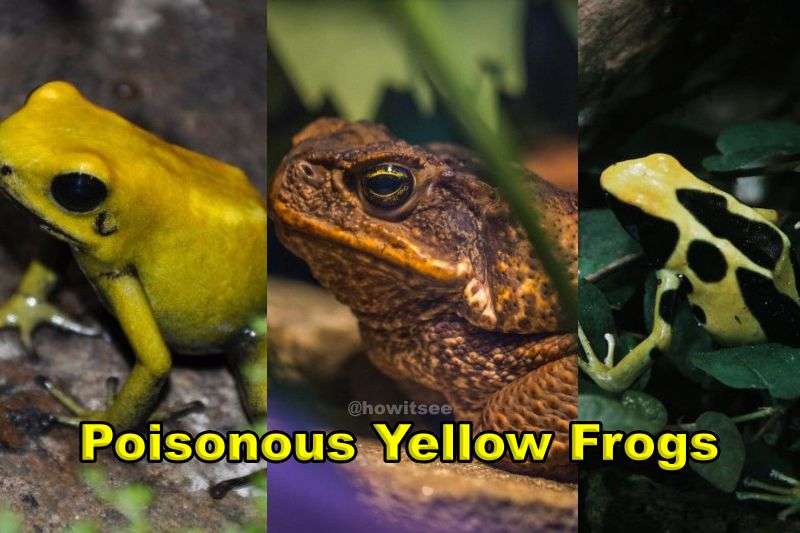Yellow, the color of sunshine, daffodils, autumn leaves, lemons, and bananas, symbolizes excitement, hope, and happiness. It is so soothing to watch it. The yellow color, when present on frogs, looks quite outlandish. Frogs are differently colored to attract potential mates, camouflage, and warn their predators. This vibrant color on frogs with various patterns signifies its danger and toxic skin to alert its predators. Today, we are going to introduce you all to 15 Types of Poisonous Yellow Frogs color frogs.
Are Yellow Frogs Poisonous?
Coloration in frogs is related to various structural adaptations, including camouflaging, attracting mates, etc., but the presence of color in frogs can’t be directly correlated with their poisonous nature. It’s not necessary for a frog to be poisonous or toxic if it’s yellow or any other color.
However, frogs’ boldly colored skin does display their toxic and unpalatable nature. Frogs have steroidal toxins such as batrachotoxin on their skin, producing toxic effects in predators’ mouths when swallowed. This adaptation in frogs protects them from predators, mostly small mammals, lizards, and snakes.
Some common yellow-colored poisonous frogs are the golden poison frog, Panamanian golden frog, mimic poison frog, corroboree frog, pumpkin toadlet, etc., which are briefly described in the article below.
Most of the poisonous frogs, belonging to the genus Phyllobates, which is also commonly known as “poison dart frogs,” secrete the most toxic poison, batrachotoxin.
This toxin, when consumed by predators, attacks the nervous system and causes various symptoms, including convulsions, muscle contractions, salivation, and even death.
15 Types of Poisonous Yellow Frogs
1) Golden Poison Frog

The Golden Poison Frog is considered to be the most toxic creature on this planet; you can get an idea of how toxic it is from the fact that the people of Embera make darts by using the frogs’ body fluids and then soaking the arrow and dart heads in them. The poison is so toxic that the weapon remains deadly for up to 2 years.
The juveniles of these species are black with two yellow streaks, but as they age, they become totally bright and golden-yellow in color. Their eyes, nostrils, mouth, and feet are black in color.
Though these are very small, they are the largest in their poison dart frog family. Typically, females are larger than males. Despite their name, there are other color morphs of these species present. They mostly eat ants, beetles, and termites, which could possibly be the source of their toxins.
- Scientific Name: Phyllobates terribilis
- Size: 30 cm
- Location: Quebrada Guangui, Colombia.
- Life Span: 6–10 years
2) Panamanian Golden Frog
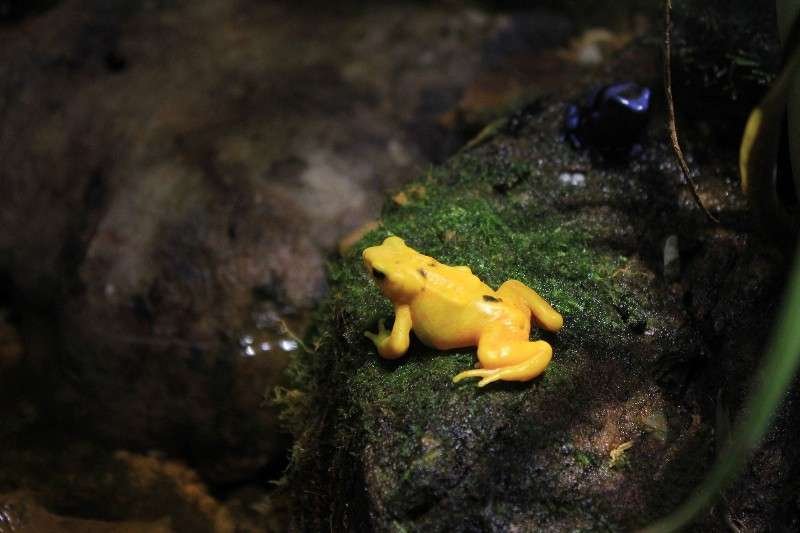
Second on the list, we have the most beautiful frog in Panama, the Panamanian golden frog, which is also a national symbol there.
The Panamanian frog is very toxic, as it secretes various types of water-soluble toxins. Large doses of its poison can attack the nerve cells, respiratory system, and circulatory system and kill within 20 to 30 minutes.
These frogs are amber-yellow and have black splotches on their back and legs. They also have yellow in their eyes.
- Scientific Name: Atelopus zeteki
- Size: 45 to 63 mm (1.8 to 2.5 in).
- Location: Panama
- Life Span: 12 years
3) Yellow-Banded Poison Dart Frog
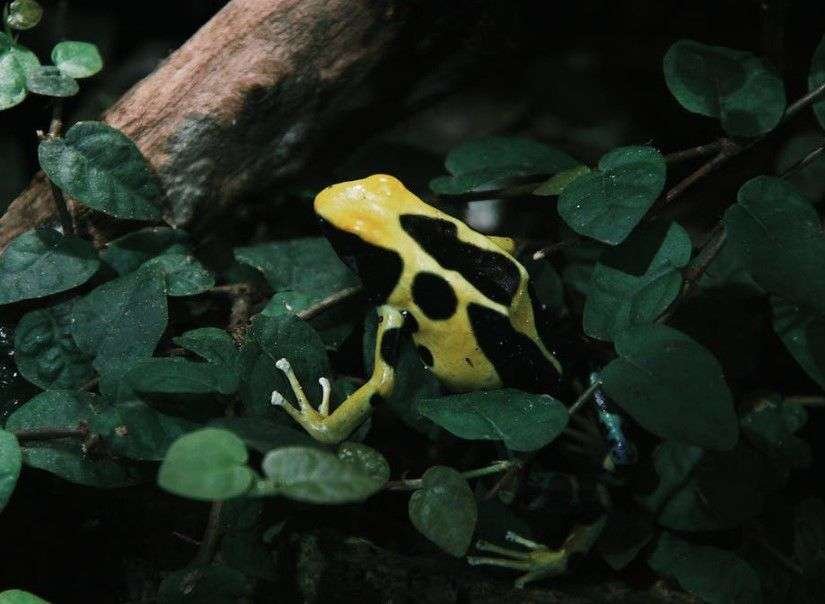
The yellow-banded poison dart frogs are found in very humid conditions in tropical rainforests, close to fresh water because they are sensitive to higher temperatures.
They are also known as “Bumblebee poison frogs” due to their yellow and black markings. Their base color is yellow with black patterns; they have broad black stripes and black splotches all over them.
They have aposematic coloration like other species of dart frogs and secrete dangerous toxins to kill their predators.
The tadpoles of these species also produce vibrations underwater to mark their presence to any other adult who could possibly place their tadpole there, and if by any chance it happens, the older one eats the newcomer.
- Scientific Name: Dendrobates leucomelas
- Size: 3.1 and 5 cm (1.2 and 2.0 in).
- Location: northern part of the continent of South America
- Life Span: 5-7 years
4) Dyeing Poison Dart Frog
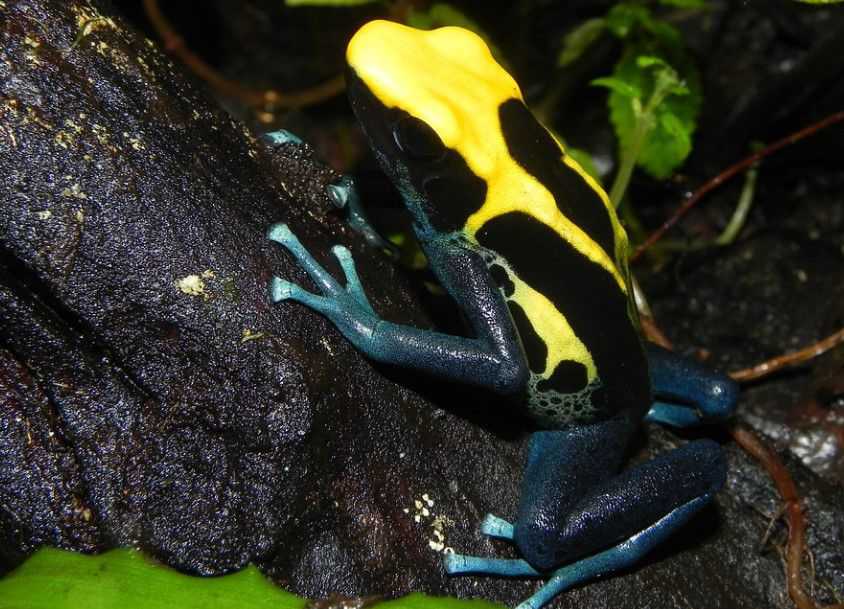
The dyeing dart frog got its name from a legend that some ancient tribes used its skin to change the color of parrots’ feathers from green to other colors.
These are highly toxic frogs that contain toxins such as pumiliotoxins and allopumiliotoxins, along with batrachotoxins, that are dangerous enough to intimidate their predators.
Various morphs of these species are known, but in this article, we are focusing on a subspecies, D. tinctorius “Citronella.” These subspecies are yellow and black, with varying degrees of yellow in different individuals and two black streaks. On some individuals, black color dots can be seen. They have navy blue legs and black eyeliner.
- Scientific Name: Dendrobates tinctorius
- Size: 50 mm (2.0 in).
- Location: South America
- Life Span: 4-6 years
5) Black-Legged Poison Dart Frog
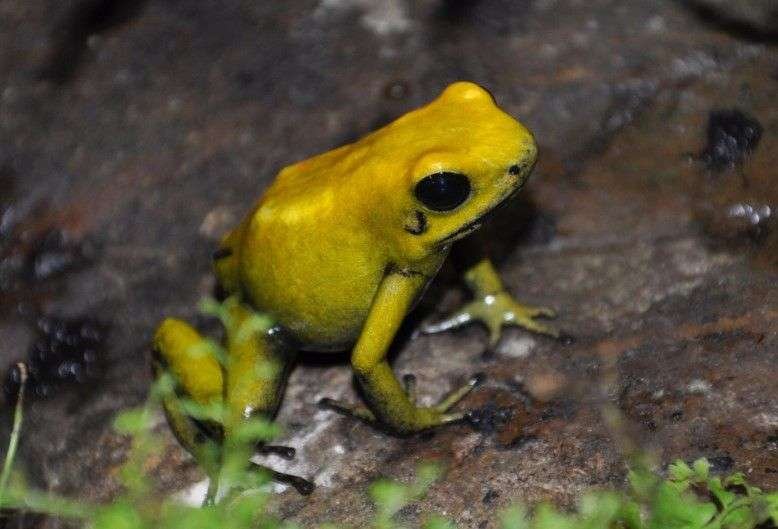
The black-legged poison dart frog is an endangered species on the IUCN Red List and is considered to be the second-most toxic dart in the world.
Sexual dimorphism is present, so females are larger than males. They are bright tangerine to golden yellow and have light green flanks. These have black-mottled upper limbs and black feet.
They are brightly colored to attract potential mates, apart from warning their predators. These are diurnal and most active throughout the daytime. P. bicolor moves across the rainforest to forage along the floor for ants, termites, beetles, or other rainforest detritus. Despite their small size, they are carnivores.
- Scientific Name: Phyllobates bicolor
- Size: 45-55 mm
- Location: Pacific coast of Columbia
- Life Span: 10–20 years
6) Zimmerman’s Poison Frog
The Zimmerman’s Poison Dart frog is quite bulky, with females being heavier than males. The tadpoles of these species are cannibalistic and eat eggs; they even wait for eggs to hatch and consume the tadpole.
Although these are green, exotic yellow breeds also exist. They have gradual coloration from yellow to green on the back and flanks, and hues of blue are seen on the limbs and feet. Black color blotches are present on the back, along with black mottled extremities.
Zimmerman’s poison frogs are known for having a chemical cues mechanism to recognize the presence of tadpoles and whether they are cannibalistic or not.
- Scientific Name: Ranitomeya variabilis
- Size: 1.6 cm
- Location: Northern Peru
- Life Span: 5-8 years
7) Harlequin Poison Frog
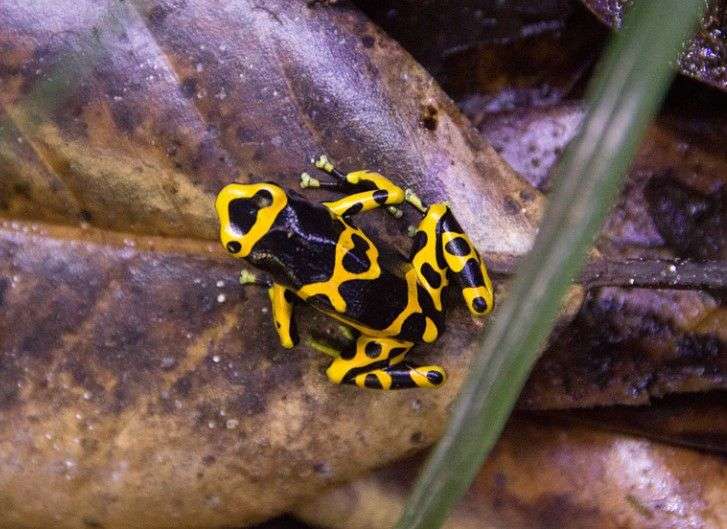
Harlequin poison dart frogs have a mustard-yellow back and a lighter yellow edge. They have orange-to-red undersides with red feet. A reticulated net-like pattern of black color is present on the snout, back, and limbs.
These frogs are also very toxic and produce fatal cardiotoxins. They are listed as “critically endangered” on the IUCN red list, but even then, they are smuggled illegally.
Their rearing behavior makes them less likely to be pets; hence, they are not widely distributed in the domestic pet market. These frogs inhabit the grounds of tropical rainforests and dwell under fallen logs or leaf litter.
- Scientific Name: Oophaga histrionica
- Size: 1.30 inches
- Location: Western Columbia
- Life Span: 8–15 years
8) Corroboree frog
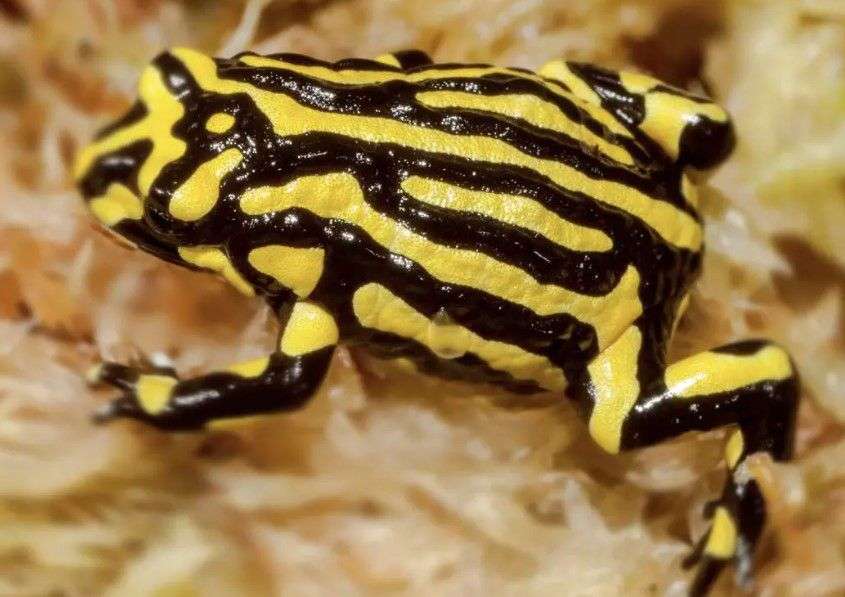
The Corroboree frog is variously colored, including orange, green, and yellow. The Yellow ones have a yellow base, covering their body with a distinct black color striped pattern which might be broken over the flanks.
Corroborees are small, poisonous, and terrestrial frogs. They are different from other poisonous frogs in that they produce their own toxins rather than obtaining them from their food sources, as in the case of most dart frogs, and these toxins have the potential to kill humans if ingested.
They inhabit small seasonal wetlands and their surrounding vegetation in the Australian Alps and feed on small invertebrates, particularly small black ants.
- Scientific Name:Pseudophryne corroboree
- Size: 2.5–3 cm
- Location: Southern Tablelands of Australia
- Life Span: 8-15 years
9) Mimic Poison Frog
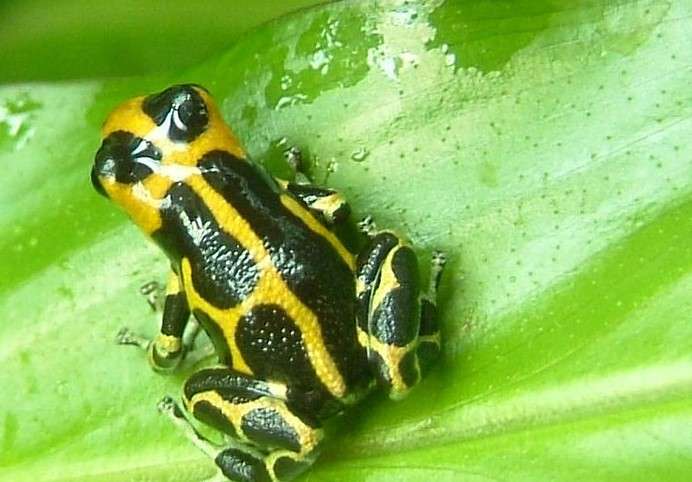
The mimic poison frog is also known as the “poison arrow“ frog and is one of thebest-known dart frogs. It is known as the “mimic poison frog” for mimicking Zimmerman’s Poison Dart frog’s striped and blotched pattern and blue-green and yellow coloration.
They have yellow, orange, or green bodies with different black color patterns; some are spotted, while others are striped. They dwell in the lower Huallaga River drainage in Peru.
These have mild toxicity in comparison to other poisonous species because of their smaller body surface area. Like other poisonous frogs, they do not produce toxins while in captivity. The males protect the eggs from other cannibalistic tadpoles.
- Scientific Name: Ranitomeya imitator
- Size: 1.3 cm
- Location: northern and northeastern Peru
- Life Span: 8–12 years
10) Pumpkin toadlet
The pumpkin toadlet is a small, diurnal, and brightly colored species. They tend to glow under ultraviolet light due to their fluorescent skeletons.
Though young toadlets are bright yellow-orange, they still lack their fluorescence. When the tadpole stage is absent, eggs hatch directly into young toadlets.
These are yellow to pumpkin orange in color and may have one to two white spots and red blemishes. They secrete a toxic poison called tetrodotoxin, which is also found in puffer fish.
- Scientific Name: Brachycephalus ephippium
- Size: 12.5–19.7 mm (0.49–0.78 in).
- Location: Southeastern Brazil
- Life Span: 7–15 years
11) Oophaga sylvatica
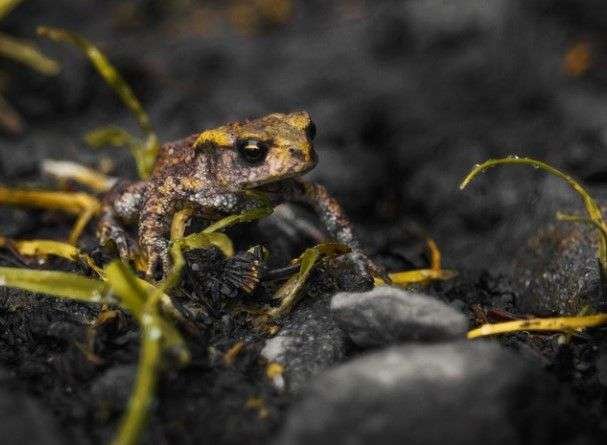
Oophaga sylvatica is commonly called diablito in the local language. They are too toxic and contain toxins like histrionicotoxin, indolizines, lehmizidines, and decahydroquinoline.
They are dappled yellow with brownish-black markings. Some morphs also have yellow or white circular spots over their reddish-yellow skin.
They inhabit lowland and submontane rainforests. Presently, it is a widespread frog in Colombia, but it is rapidly disappearing from much of its Ecuadorian range due to habitat loss (deforestation) and agricultural pollution.
- Scientific Name:Oophaga sylvatica
- Size: 26-38 mm
- Location: Southwestern Colombia and Northwestern Ecuador
- Life Span: 8-12 years
12) Cane toad
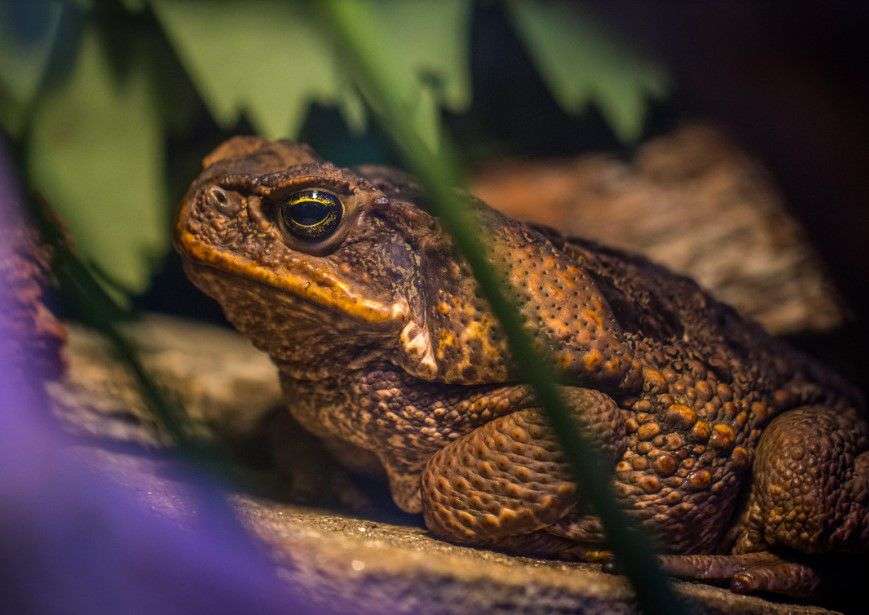
The Cane toad, also known as the “marine toad” or “giant neotropica” toad, is a true ground-dwelling toad that belongs to the genus Rhinella.
These toads have poisonous parotid glands behind their shoulders that secrete milky poison-containing bufotoxins, which is highly toxic.
These are dry, warty, cup-sized toads with tan-yellow skin, some appearing dusty and rufous. Licking them can really make you high because of the secretions’ psychedelic effect.
- Scientific Name: Rhinella marina
- Size: 10–15 cm (4–6 in).
- Location: South and mainland Central America
- Life Span: 10–15 years
13) Red-headed Poison Frog
Red-headed poison frogs reside in primary and older secondary-growth wet forests naturally. They have a vital need for phytotelmata (water-holding flowers) for breeding, which must be present in their surroundings.
They have shiny gold color from their snout to their neck and a big black spot between their eyes. The underparts are blue with black splotches on the back and small spots on the legs. White streaks are present on the lower dorsal side too.
These dwell in standing water that is present in the axils of plants, and females lay eggs there. The male carries young ones away from the flower because of cannibalistic tadpoles.
- Scientific Name: Ranitomeya fantastica
- Size: 1.4 cm
- Location: Peru
- Life Span: 6–10 years
14) Golden Rocket Frog
The Golden Rocket Frog is also known as “Beebe’s Rocket Frog.” It dwells upon the giant bromeliad as it provides a safe place for oviposition and tadpole rearing.
It is yet a matter of debate whether the bright coloration is a sign of aposematic behaviour or a sex recognition signal, but there is a high chance it could be due to its poisonous nature.
The females of these species are shiny and golden-colored, whereas the males are mottled tanish brown; this phenomenon is known as reverse sexual dichromatism. Some mature orange-colored females of these species are seen too. Occasionally, the females of these species lay unfertilized eggs in the phytotelmata bromeliads for the tadpoles to consume for nutritional purposes.
- Scientific Name: Anomaloglossus beebei
- Size: 16.80 mm
- Location: Guyana
- Life Span: 10–15 years
15) Yellow-Bellied Albino Toad
The albino morph of the yellow-bellied toad is a great choice for a pet frog. They have vibrant yellow coloration with hues of yellow patches on the belly; that’s why they are named “fire-belly toads,” have bumpy skin, and are sexually dimorphic.
Warts present on the skin help them to open up their poisonous glands and secrete toxins. Though when in captivity, they become non-toxic.
- Scientific Name: Bombina variegata
- Size: 28–56 mm
- Location: Western Europe
- Life Span: 5-23 years
Conclusion:
Poisonous frogs that are yellow in color are present in the wild with different kinds of hazardous toxins that produce spine-chilling effects in their predators. Who knew these cute creatures could be such a deadly killers? Now you know. Here we conclude our article on, “15 Types of Poisonous Yellow Frogs On Earth.” We hope you like this post.
Also Read:

Hey there! I’ve been the kid who used to love watching all the science stuff and that fascination lead me to choose Zoology as my Major in Graduation. I’m a self-taught writer and spend my time writing scintillating content on animals. I love observing animals behavior and their bond with humans. I want to give my point of view regarding animals i research about. I had done several projects on animals during my graduation and learned their behavior thoroughly.
